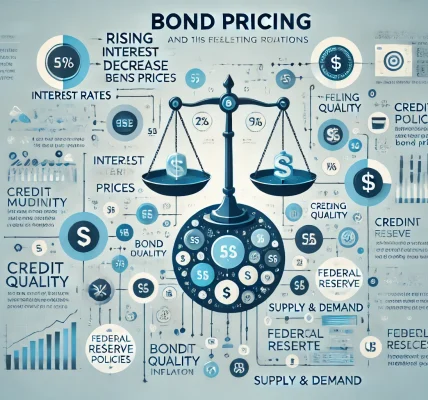Introduction
Investing in corporate bonds can be a lucrative way to earn steady income while diversifying your portfolio. However, as with any investment, it’s essential to evaluate the potential risks and rewards before making a decision. Corporate bonds, unlike government bonds, carry a higher degree of risk, as they are issued by companies, and their repayment depends on the financial health of the issuer.
In this blog, we will explore how to evaluate corporate bonds for safety and returns. Whether you’re a beginner or an experienced investor, understanding how to assess the risk and reward potential of corporate bonds will help you make informed investment choices. By the end of this post, you’ll know exactly what to look for when evaluating corporate bonds.
What Are Corporate Bonds?
Corporate bonds are debt securities issued by companies to raise capital for various purposes, such as expansion, research and development, or paying off existing debt. When you buy a corporate bond, you are lending money to the company, and in return, you receive periodic interest payments (also known as the coupon) and your principal back at maturity, assuming the company does not default.
Corporate bonds can offer higher yields than government bonds due to the higher risk associated with lending to private companies. However, it’s important to assess each bond’s safety and return potential to ensure that you are making a sound investment.
Factors to Consider When Evaluating Corporate Bonds
Here are the key factors you should consider when evaluating corporate bonds:
1. Credit Rating of the Issuer
The credit rating of the bond issuer is one of the most important factors in evaluating corporate bonds. Credit rating agencies such as Standard & Poor’s (S&P), Moody’s, and Fitch assign ratings to corporate bonds based on the issuer’s ability to repay debt. These ratings give investors a quick way to assess the risk associated with a bond.
- Investment-grade bonds (rated BBB or higher) are considered low-risk bonds because they are issued by financially stable companies with a strong track record of repaying debt.
- Non-investment-grade or junk bonds (rated below BBB) carry a higher risk of default but offer higher yields to compensate investors for the increased risk.
As a general rule of thumb, if you’re looking for safety, focus on investment-grade bonds, as they are more likely to generate consistent returns with a lower risk of default.
2. Bond Yield and Coupon Rate
The bond yield and coupon rate are essential in determining the return you can expect from a corporate bond. The coupon rate is the interest rate the company pays you annually, based on the bond’s face value. The yield is the overall return you can expect, which takes into account the bond’s price in the market.
When evaluating corporate bonds, look for:
- Higher coupon rates: Bonds with higher coupon rates tend to offer higher income, but this usually correlates with higher risk.
- Yield-to-maturity (YTM): YTM represents the total return you can expect if the bond is held until maturity, taking into account its current market price, coupon payments, and face value. This gives you a more accurate picture of the bond’s long-term return potential.
- Yield-to-call (YTC): For callable bonds, the yield-to-call is the return you would earn if the bond is called (redeemed early) by the issuer before maturity.
Remember, the yield you earn from a bond is highly dependent on the bond’s price. Bonds purchased at a discount (below face value) offer higher yields, while bonds purchased at a premium (above face value) provide lower yields.
3. Issuer’s Financial Health
The financial health of the bond issuer is another critical factor in evaluating corporate bonds. Strong financial health generally means that the company has the ability to meet its debt obligations. You can assess the issuer’s financial health by looking at key financial ratios, such as:
- Debt-to-equity ratio: This ratio compares the company’s total debt to its equity capital. A lower debt-to-equity ratio suggests the company is less leveraged and may be less risky.
- Interest coverage ratio: This ratio measures the company’s ability to meet its interest payments with its earnings. A higher interest coverage ratio indicates that the company generates enough revenue to cover its debt obligations.
- Cash flow analysis: Look at the company’s operating cash flow. Companies with strong and consistent cash flow are more likely to meet their bond payments.
Also, review the company’s credit report and any recent news that could impact its financial health. If the company is facing significant financial challenges or declining revenues, it could affect its ability to repay bondholders.
4. Bond Maturity
The maturity date of a bond refers to when the issuer is required to pay back the bond’s principal amount. The bond’s maturity affects its risk and return characteristics. Longer-term bonds tend to offer higher yields to compensate for the additional risk associated with inflation and interest rate fluctuations.
- Short-term bonds (1-3 years) typically offer lower yields but are less sensitive to interest rate changes.
- Intermediate-term bonds (4-7 years) strike a balance between risk and return.
- Long-term bonds (7+ years) usually offer higher yields but are more vulnerable to interest rate changes and inflation.
Consider your investment horizon and risk tolerance when evaluating a bond’s maturity. If you’re risk-averse, shorter-term bonds might be more appropriate, as they are less exposed to market fluctuations.
5. Economic and Market Conditions
The broader economic and market conditions play a significant role in determining the performance of corporate bonds. Factors such as inflation rates, interest rates, and economic growth can affect bond prices and yields.
- Interest rate environment: Corporate bonds tend to perform better in low-interest-rate environments. Rising interest rates can negatively impact bond prices, especially for long-term bonds. Be sure to consider the direction of interest rates when evaluating bonds.
- Inflation: Inflation erodes the purchasing power of fixed-income payments. If inflation is high, bonds with fixed coupon rates may offer lower real returns.
- Economic cycles: Corporate bonds are sensitive to economic cycles. During periods of economic growth, corporate bonds may perform well, while during recessions, high-yield bonds may experience increased defaults.
6. Bond Covenants
Bond covenants are conditions set by the issuer to protect bondholders. They can include clauses that restrict the company’s ability to take on additional debt, sell assets, or make large acquisitions. Bonds with strong covenants provide extra protection for investors and can reduce the risk of default.
Review the covenants before investing to ensure that the bondholder’s interests are adequately protected.
7. Issuer’s Industry and Sector
Different industries and sectors come with varying degrees of risk. For example, bonds issued by companies in stable industries, such as utilities or healthcare, tend to have lower default risks than those issued by companies in cyclical industries, such as technology or retail.
Consider the industry in which the issuer operates and evaluate its potential for growth and stability. Understanding the industry dynamics can provide valuable insight into the company’s ability to repay debt.
Conclusion
Evaluating corporate bonds for safety and returns requires a comprehensive approach that takes into account the bond’s credit rating, yield, the issuer’s financial health, maturity, economic conditions, and more. By carefully considering these factors, you can make more informed investment decisions that align with your risk tolerance and financial goals.
Before investing in corporate bonds, take the time to do your research, understand the risks involved, and diversify your bond investments to mitigate potential losses. Whether you’re looking for safety or higher returns, the right corporate bonds can play a key role in your investment strategy.




